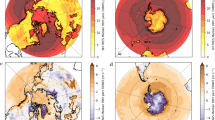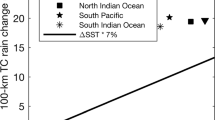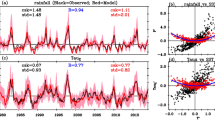Abstract
Replying to B. Wang, S. Xu & L. Wu Nature 489, 10.1038/nature11470 (2012)
Arabian Sea tropical cyclones have become stronger over the past 30 years owing to a reduction in vertical wind shear (VWS) brought about by radiative forcing from pollution aerosols1. Wang et al.2 argue that the decline in VWS results from a systematic shift in storm genesis date, which may be part of a natural cycle or another consequence of regional pollution. However, their conclusions2, although interesting, are not supported by our analysis and are probably sensitive to biases in the observational record.
This is a preview of subscription content, access via your institution
Access options
Subscribe to this journal
Receive 51 print issues and online access
$199.00 per year
only $3.90 per issue
Buy this article
- Purchase on Springer Link
- Instant access to full article PDF
Prices may be subject to local taxes which are calculated during checkout

Similar content being viewed by others
References
Evan, A. T., Kossin, J. P., Chung, C. E. & Ramanathan, V. Arabian Sea tropical cyclones intensified by emissions of black carbon and other aerosols. Nature 479, 94–97 (2011)
Wang, B., Xu, S. & Wu, L. Intensified Arabian Sea tropical storms. Nature 489, http://dx.doi.org/10.1038/nature11470 (2012)
Kanamitsu, M. et al. NCEP-DOE AMIP-II Reanalysis (R-2). Bull. Am. Meteorol. Soc. 83, 1631–1643 (2002)
Evan, A. T. & Camargo, S. J. A climatology of Arabian Sea cyclonic storms. J. Clim. 24, 140–158 (2011)
Chung, C. E. & Ramanathan, V. Weakening of North Indian SST gradients and the monsoon rainfall in India and the Sahel. J. Clim. 19, 2036–2045 (2006)
Lau, K.-M. et al. The joint aerosol-monsoon experiment. Bull. Am. Meteorol. Soc. 89, 369–383 (2008)
Meehl, G., Arblaster, J. & Collins, W. Effects of black carbon aerosols on the Indian monsoon. J. Clim. 21, 2869–2882 (2008)
Ramanathan, V. et al. Atmospheric brown clouds: impacts on South Asian climate and hydrological cycle. Proc. Natl Acad. Sci. USA 102, 5326–5333 (2005)
Knapp, K. P., Kruk, M. C., Levinson, D. H., Diamond, H. J. & Neumann, C. J. The International Best Track Archive for Climate Stewardship (IBTrACS): unifying tropical cyclone data. Bull. Am. Meteorol. Soc. 91, 363–376 (2010)
Author information
Authors and Affiliations
PowerPoint slides
Rights and permissions
About this article
Cite this article
Evan, A., Kossin, J., ‘Eddy’ Chung, C. et al. Evan et al. reply. Nature 489, E2–E3 (2012). https://doi.org/10.1038/nature11471
Published:
Issue Date:
DOI: https://doi.org/10.1038/nature11471
This article is cited by
-
Nature and impact of extremely severe cyclone Tauktae over India
Discover Oceans (2024)
Comments
By submitting a comment you agree to abide by our Terms and Community Guidelines. If you find something abusive or that does not comply with our terms or guidelines please flag it as inappropriate.



